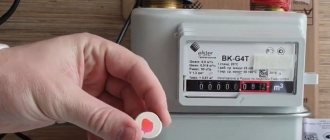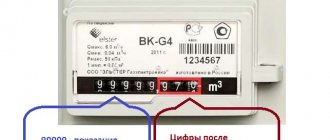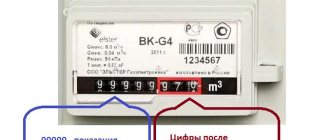The need to save causes negative emotions. Rational economics is perceived completely differently. That is, there is no need to give up something, but you should wisely use what is available. It is precisely this attitude towards natural resources that is promoted by a gas meter for a private home. Using exactly as much as you need and paying only for what you use is prudent and fair.
A gas meter helps you save significantly and pay only for the volume of gas used
How a gas meter works: general operating principle
Natural gas is supplied as fuel to private homes. During storage and transportation, it is supplemented with other substances that make it more acceptable and safe for everyday use. The main component of the gas supplied to residential buildings (what type of devices are used does not matter) is methane (75–95%), and it also contains:
Measuring methods and information output for different meter models are based on different engineering principles
- carbon dioxide;
- propane;
- butane;
- hydrogen sulfide;
- water in a vapor state.
Natural gas is odorless, but any leak in a residential area is noticeable almost immediately. This is a consequence of the addition of odorants, which are easily detected by the human sense of smell and make methane a relatively safe fuel.
To record the amount of gas consumed, meters are used. The main elements of the meters are the housing, the chamber (where gas enters from the gas pipe), the metering mechanism and the digital display. Methods for measuring and providing information for different models may be based on different engineering principles, which entails features of the case, installation methods, etc.
It is not difficult to understand the general principle of how and in what quantities gas is measured. The meters allow a certain volume to pass through, which means that the unit of measurement for natural gas is cubic meters. That is, the entire amount of gaseous fuel used is divided into cubes, the digital value of which is reflected on the meter display.
Gas meters: law and regulations on the need for installation
Campaigns for the mass installation of gas meters either intensify or subside. First of all, consumers themselves are interested in accounting, since after connecting the device they will not pay for the amount determined by the maximum consumption, but for the actual cubes used. For various reasons, there are still a significant number of gas users who have not installed meters.
Today, those who use natural gas for cooking do not have to install a gas meter
The government has seriously taken up the issue of accounting for gas costs. In 2009, the Law “On Energy Saving and Increasing Energy Efficiency and on Amendments to Certain Legislative Acts of the Russian Federation” was adopted. According to this document, gas meters had to be installed before 2015. It turned out to be impossible to fulfill the requirement due to the fact that it was impossible not only to install meters, but also to provide users with the required number of devices.
The date was postponed, changes and additions were made to the Law. Even the requirement for mandatory installation of meters has been lifted. Today, those who use natural gas for cooking and heating water (that is, have a gas stove and water heater) may not install the device. Those who heat the premises and consume more than 2 m3/h are required to install meters.
The procedure for installing a gas meter in a private house
If it is necessary to install a meter, the first step is to submit an application to the organization that services the gas supply networks in the city (or region). You must have with you:
- identification document (passport);
- certificate of ownership of the home;
- technical documentation for the building, for the installed gas equipment (if it is already installed).
When installing a gas meter by service specialists, they will be both performers and receivers
Helpful advice! To avoid an unsuccessful visit, before submitting an application, you should contact the gas service to clarify the list of documents. The phone number can be found on the back of the payment slip.
In order to decide how to install a gas meter, specialists come out. In agreement with the owner and taking into account the necessary conditions, the location of the device is planned. In a private house, the meter can be installed both indoors and on the outer wall of the building. A prerequisite for the external position of the device must be accessibility and protection from direct sunlight and precipitation.
The result of the visit and selection of a location is the issuance of “Technical conditions for the installation of a gas meter.” This document gives the right to contact an organization that, based on the specifications, will carry out the “Project for installing a gas meter.”
Resolution No. 410 dated May 14, 2013 identifies a circle of organizations that have the right to install, repair and dismantle gas equipment. It is better to contact the installation specialists of the organization that maintains the networks, since in the end it is they who will put the meter into operation. Consequently, when installation work is performed by service specialists, they will be both performers and receivers.
In order to understand where and how to install a gas meter, you need to invite specialists
Gas meters for a private home: installation price, necessary conditions
Installing a gas meter requires certain financial costs. The main ones are the following:
- purchasing a meter;
- payment for the development of “Technical Conditions”;
- costs of creating an “Installation Project”;
- payment for installation work.
To eliminate claims from gas service specialists when putting the meter into operation, it is worth knowing the basic requirements for its placement. They are regulated by SNiP 42-01-2002 and SP 42-101-2003. The rules regarding the gas meter are as follows:
- the location must be accessible for installation, maintenance and repair;
- installation height (from the floor to the meter) – at least 1.5 m;
- the meter should be placed at a distance of at least 1 m from gas consuming equipment (dispenser, stove, boiler);
- the metering device can be installed in an adjacent room, separated from the one equipped with gas appliances by a wall with a doorway;
- The counter must be removed from the wall by 3–5 cm to create anti-corrosion conditions.
Street gas meters for private homes are more demanding. The cost of their installation is significantly higher than the cost of installing a room version due to the need to perform a greater amount of work and use of materials. Exiting the gas meter outside means additional pipes, making a canopy or box to protect the device from sunlight and precipitation.
The cost of installing street gas meters significantly exceeds the cost of installing indoor models
Helpful advice! To place the meter, it is better to choose a room with good ventilation. If it is absent, specialists will prohibit installation in such a place or require ventilation.
Gas meter for a private home: commissioning
The commissioning of a metering device largely depends on the quality and design of the installation work. They must be carried out by qualified personnel using certified equipment and appropriate materials.
After installing the meter, gas service workers (or others authorized to carry out this work) must check the operation of the device. Attention is drawn to the following:
- for job stability;
- whether interference occurs during the passage of gas through the device;
- for gas leaks;
- It is necessary to record the readings at the time of installation.
The commissioning of a gas meter for a private house depends on the quality of installation work
If there are no traces of defects or malfunctions, a certificate of completion of work is drawn up. This document reflects:
- address and date of installation;
- serial number of the meter;
- information about the workers who performed the installation;
- assessment of the stroke of the counter mechanism;
- device readings at the time of connection;
- date of scheduled meter verification.
Installation of a gas meter (price of installation work), depending on the complexity of the work, costs consumers 1,500–3,000 rubles. The payment receipt is attached to the work completion certificate, drawn up in three copies, one of which is handed over to the customer.
Then you need to call a specialist from the gas service to seal the device. He checks the installation's compliance with the design documentation; if there are no complaints, installs a seal and draws up a report.
After all the above procedures, an agreement is concluded with the direct gas supplier for payment and maintenance of gas equipment, and the rights and obligations of the parties are determined.
After installing the device, you must call a specialist from the gas service to seal the meter
Procedure for replacing equipment
The first stage of the algorithm for replacing the metering device is concluding an agreement with the company that supplies gas to the area of residence. The subject of the agreement is a set of measures to replace the device. Motive - an application submitted by the owner of the premises.
Private gas companies operate in large cities. They have the appropriate licenses, and their employees are certified and authorized to work with gas equipment. When contacting them to change a flow meter, you must request supporting documents.
First visit to a specialist
At the first visit after concluding the contract, the technician must confirm or deny the need to purchase and install a new device. There are often situations when, to restore functionality, it is enough to install a new battery or perform inexpensive repairs.
Types of gas meters for a private home: general characteristics
The Russian market today is quite filled with various models of gas meters. Dozens of domestic enterprises are engaged in their production; a significant number of devices are imported from abroad. Competition contributes to the constant improvement of manufacturing technologies, which ensures an increase in the quality of this measuring equipment.
Before talking about the differences in types of gas meters, it is worth paying attention to the characteristics inherent in any model:
- indicator of the maximum level of blue fuel consumption;
- permissible temperature limits at which the meter can function normally;
- type and size of threaded connections;
- distance between connecting elements;
- timing of scheduled verification.
According to the method of indication (displaying numbers), counters are divided into:
- to mechanical;
- electronic.
According to the method of displaying numbers, gas meters are divided into mechanical and electronic
Mechanical devices are inexpensive, easy to operate, durable, but quite noisy and susceptible to temperature. Electronic models have a more interesting design, accurately reflect readings, are resistant to temperature changes, and are silent, but they cost a lot of money.
Helpful advice! When choosing the type of meter, you should consult with gas service workers who have personal experience in maintaining these gas measuring devices.
Membrane model of gas meters for a private home
Based on the features of the counting mechanism, gas metering devices are divided into types:
- membrane;
- rotary;
- turbine;
- vortex.
Membrane models are mainly used for installation in private homes. Such a device consists of several chambers separated from each other by movable doors. The operating principle of a gas meter with such a mechanism is presented as follows:
Membrane meters are most often used for installation in private homes.
- A certain amount of gas enters one chamber.
- When it overflows, it causes a change in the diaphragm, which pushes the valves.
- When the valves are opened sequentially, the gas flows into another chamber, and the valves close behind it.
- The process of movement of the valves triggers a cross mechanism that sets the “star” in motion. It is the “asterisk” that allows you to count the amount of gas that has passed through the meter, that is, the gas used.
This device is quite simple and has a reasonable price. The membrane meter readings are accurate. Disadvantages include high noise levels and significant dimensions. Considering that in private homes they try to move meters outside of residential premises, the listed negative characteristics will not cause significant inconvenience during operation. Membrane meters have the longest service life - 30 years.
Electronic street gas meter for a private home
When choosing between mechanics and electronics, they often give preference to the latter. Modern, accurate, fast. A similar trend has emerged in the public utilities sector. The advantages of this type of gas measuring instruments are obvious:
- small sizes;
- nice design;
- easy operation.
Electronic gas meters have the following advantages: small size, easy operation, nice design
Installation is quite easy; no welding is required during installation. The devices are highly accurate; information about the amount of gas consumed instantly appears on the display. The numbers are displayed large, bright, and readable.
This gas meter can be installed both indoors and outdoors. It is not afraid of temperature fluctuations and works silently. When an additional device is connected, information from the display can be read and transmitted to the server. The verification interval for electronic meters is 12 years.
It is quite clear that the price of such devices differs significantly from the cost of membrane models. Today it ranges from 4,000 to 10,000 rubles.
Helpful advice! If the only gas appliances used in your home are a stove and a water heater, it is worth purchasing an electronic meter. The acquisition costs will be offset by the low cost of installation.
When choosing between mechanical and electronic meters, users increasingly prefer the latter
Smart technologies and utility meters on poles
Many people have long decided for themselves how to choose a gas meter. The main criterion is the use of the most modern technologies. The last word in the production of household gas measuring instruments has become “smart” meters. The definition of “smart” applies to technology that does a lot on its own.
Such a gas meter only requires installation from the user. The rest is done without human intervention. The device itself reads and transmits readings, and also signals interruptions in operation. To ensure the functioning of smart meters, wireless Internet and installation of the application on one or several gadgets are required.
Considering that gas meters in private homes are not located in residential premises, it is better to purchase a modem that provides a strong signal. Then the device will work normally, even if it is installed in a boiler room attached to the house.
If it is inconvenient to place them in rooms with other gas appliances or if there are no separate rooms, meters are installed at the entrance of the gas pipe into the house.
“Smart” meters themselves read and transmit readings and signal about interruptions in operation
A pole is used as a basis for securing the protective box. The result is a functional and quite attractive yard design composition.
Important! Before purchasing a “smart” meter for external installation in a private home, you need to make sure that it is possible to provide a Wi-Fi signal in the area where the device is located.
Mandatory verification and inspection of gas meters for private homes
Verification and testing have the same goal - to establish the suitability of the device for further use. In this case, two terms will be used to highlight the features of one and the other procedure.
The user is responsible for the integrity of the device and seal. He must periodically inspect the meter and, if defects are found, must immediately notify the gas service. Malfunctions include:
The consumer is responsible for the integrity of the meter and seals.
- damage to the body;
- violation of the integrity of the seal;
- doubts about the correctness of the testimony;
- suspicions of incorrect operation of the counting mechanism.
These obligations are specified in the agreement concluded between the consumer and the organization servicing gas networks. The obligation on the part of the service is to eliminate deficiencies within a month, as well as check the condition of the gas meter, the timing of which is defined in the document as once every six months.
The verification interval for the gas meter is determined by the manufacturer and is noted in the product passport. This type of check involves removing the device. (Verification of certain types of meters does not require their dismantling, but such models are practically not used in private homes). Ensuring that the device is delivered to the metrological service for verification is the responsibility of the user. Transportation is preceded by unsealing and dismantling of the meter, which can only be performed by specialists.
Repair or replacement?
In some situations, replacing equipment may be more profitable than carrying out verification and repair work. If the device breaks down, you will have to pay for the dismantling work, examination and, if it is impossible to restore correct operation, a new flow meter and its installation.
Moreover, all the time spent on these manipulations, gas fees will be calculated based on regional standards.
Therefore, many users who suspect a major breakdown of the device prefer to immediately install a new meter. The old one is either disposed of or, after successful repair, stored as a spare until the end of its service life.
Cost of a gas meter for a private home
Before installing a meter, every consumer asks the question of how much a gas meter costs for a private home. To get an answer, simply looking at the digital prices in the catalogs of trading companies will not be enough. It is necessary to understand the operating principle of metering devices, compare different options, get acquainted with the opinions of experienced users, and only then evaluate the cost of a particular device.
The average price of household gas meters varies between 2000-3000 rubles
Helpful advice! When assessing the objectivity of the cost of the meter, one should take into account both the quality of the device and the durability of its operation.
The average price level for household gas meters is 2000-3000 rubles.
These are domestically produced membrane models with a mechanical counting method and a nominal throughput of up to 6 m3/h.
For example, a VK G4 gas meter costs 2,200 rubles; The VK G4T device has a price of 3,400 rubles, where “T” means the presence of a temperature compensation mechanism.
A gas meter from Polish manufacturers METRIX G6 is sold at a price of 6,000 rubles. Imported production and electronic accounting system double the cost.
The price of “smart” meters reaches 10,000 rubles.
The cost of a gas meter is affected by the throughput and counting mechanism
The increase in the cost of a gas device, in addition to the features of the metering mechanism, is largely influenced by the throughput of the device: the larger it is, the higher the price of the meter.
Popular models of gas meters for private homes
Models that have proven themselves well during operation are becoming popular. Quite often, even the price fades into the background. If both indicators suit the consumer, demand actively increases.
“Grand” meters should be classified as such devices. They may have different bandwidths. The distinctive characteristics of these devices are:
- small sizes;
- energy independence;
- easy installation;
- resistance to temperatures and dirt;
- accuracy of readings;
- long warranty period (12 years).
Those models that have proven themselves become popular among consumers
Electronic meters "Grand" very rarely fail. They can be mounted in both vertical and horizontal positions.
One of the best gas meters for a private home are also Betar gas meters. The models have a fairly high technical level, many are equipped with a heat correction function. The devices are small-sized and can be installed in both vertical and horizontal planes. The model range includes devices with remote control that can be connected to an autonomous Smart Home system.
Helpful advice! Information about the popularity of individual meter models is based on user reviews and information on the Internet. When choosing a device, you should definitely consult a specialist.
Gas meter: which one is better for a private home
When choosing a gas meter for a private home, you must consider the following indicators:
- number of gas equipment units;
- family composition;
- meter installation location.
You need to start choosing a gas meter for a private home after determining its location
The volume of gas used depends on the number of consumers and types of installed gas appliances. If only a water heater and a gas stove are placed in the house, a meter with a throughput capacity of up to 2.5 m3/h is sufficient. It is worth choosing counters marked G-1.6. If the heating in the house is also gas, a G-4 or G-6 meter will do.
Before choosing a gas meter for a private home, you need to determine its location. When hanging externally, the influence of temperatures increases; the range should be -40 – +50 °C. Therefore, it is necessary to carefully study the passport data before purchasing the device. An important option for an outdoor gas meter is thermoregulation. The built-in function will eliminate the need to use an additional coefficient when calculating payment.
Helpful advice! When placing the gas meter externally, in order to prevent exposure to sunlight and moisture, it is better to purchase a ready-made metal protective box. It is as sealed as possible, the dimensions correspond to the dimensions of the device.
Conclusions and useful video on the topic
The meter is replaced when it breaks down and at the end of its service life. The initiator can be the owner himself or a representative of the gas service. When choosing a device, you should listen to the opinion of a professional, since only he can take into account all the technical details.
Installation should also be entrusted to specialists. This is roughly how their installation visit goes:
After completing the work, the gas service employee must draw up two reports: on replacement and on putting the device into operation. After this, all that remains is to put a seal and monitor the condition of the new flow meter.
Do you have anything to share with other flow meter owners? Write using the form below. It is also possible to attach photos, scans of technical passports, write comments and ask questions. Exchange of opinions is an opportunity to get useful tips, join us.
Gas meters for private homes: user reviews
You should definitely read reviews about the device chosen for installation. I would like to draw the attention of people who are skeptical about their veracity to the following: a true opinion can always be recognized. If a person actually used the device, this will definitely show up. Although the opinion may not always be agreed with.
Reviews of gas meters will help you decide on the final choice of device
“Without a meter, gas bills go through the roof. Four are registered. The meter was installed immediately after purchasing the house, when it was being renovated. Heating – electric heated floor. Gas meter SGM-1.6. Small, white. I hid it in a wall cabinet in the kitchen. I had to tinker a little with the gas inlet. I can't hear the work. I made a mistake, I didn’t make a separate door for the cabinet, it was installed under the common one, so they would have completely forgotten that the device was there. Third year no problems.”
Evgeniy, Voronezh
“I installed an electronic one, Grand, it was highly recommended. Bandwidth 3.2. There is a thermostat. Worked great for four years. Then the screen went dark. It turned out that the problem was with the battery. They removed it, unsealed it, sealed it... I was outraged that it did not work for the promised 10 years, there was a lot of hassle with replacement. I asked to take time off from work three times. Before the problem appeared, I thought it was an ideal meter.”
Alexander, Tula
“Betar mechanical has been working for seventeen years. Hung it in the outbuilding without any closing device. Once they took me away for verification. It doesn't make any noise, we walk past and don't hear anything. The device is reliable."
Peter, Omsk
There are different opinions about gas meters; reviews of other models also differ in content. In general, there are more positive opinions about the use of meters to record gas consumption. If you want to get as much information as possible about a specific device, you should look at the reviews on the manufacturer’s website about the model you like.
Reviews can be read both on the manufacturer’s website and on other Internet resources.
Installation quality control
Work must be carried out taking into account safety rules:
- The distance from the meter to gas equipment cannot be less than one meter.
- Outside the home, the device can be installed under a moisture-proof canopy or inside a metal cabinet.
- The standard placement height is 160 cm. Any deviations must be confirmed by the technical data sheet of the product.
- There should be no heating devices within a radius of 2 meters.
- The device must be within visibility and easy access.
- The distance between the meter and the wall should be more than 5 cm. This ensures natural ventilation and slows down the formation of corrosion on metal parts.
- Upon completion of installation, a leak check is required. Previously, this was done by applying a soap solution. Now representatives of gas companies are increasingly giving preference to electronic sensors.









